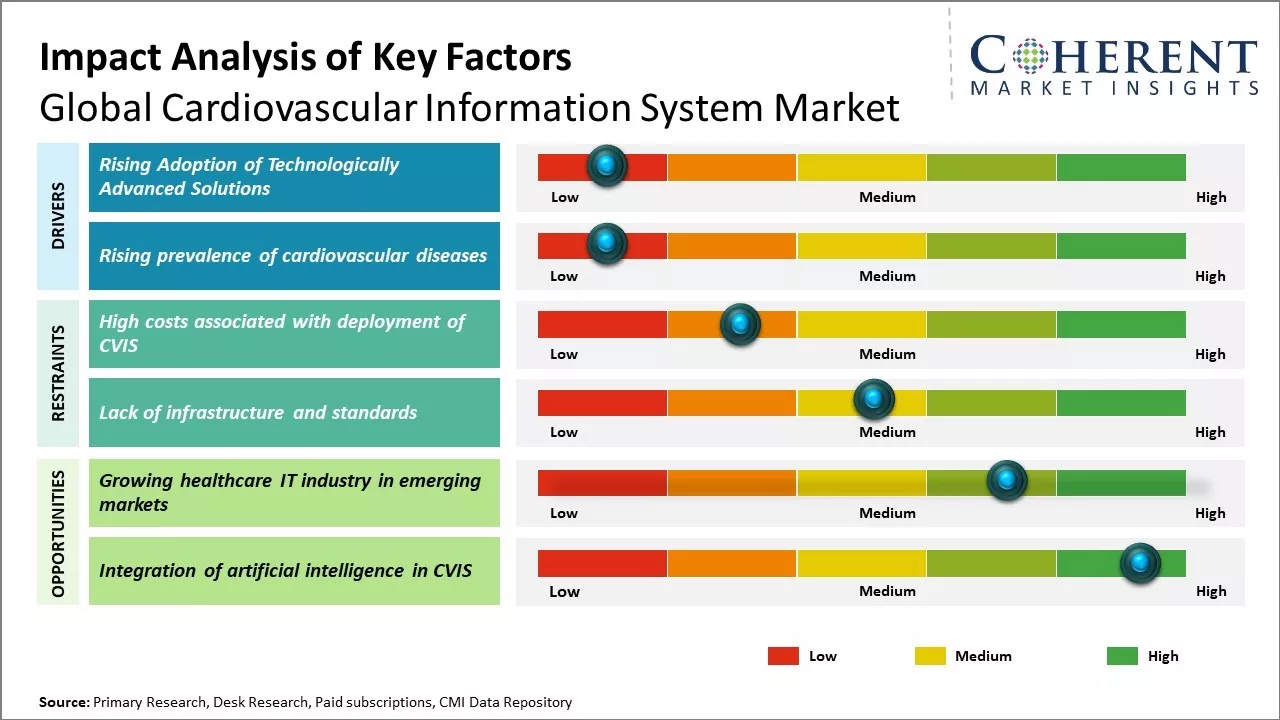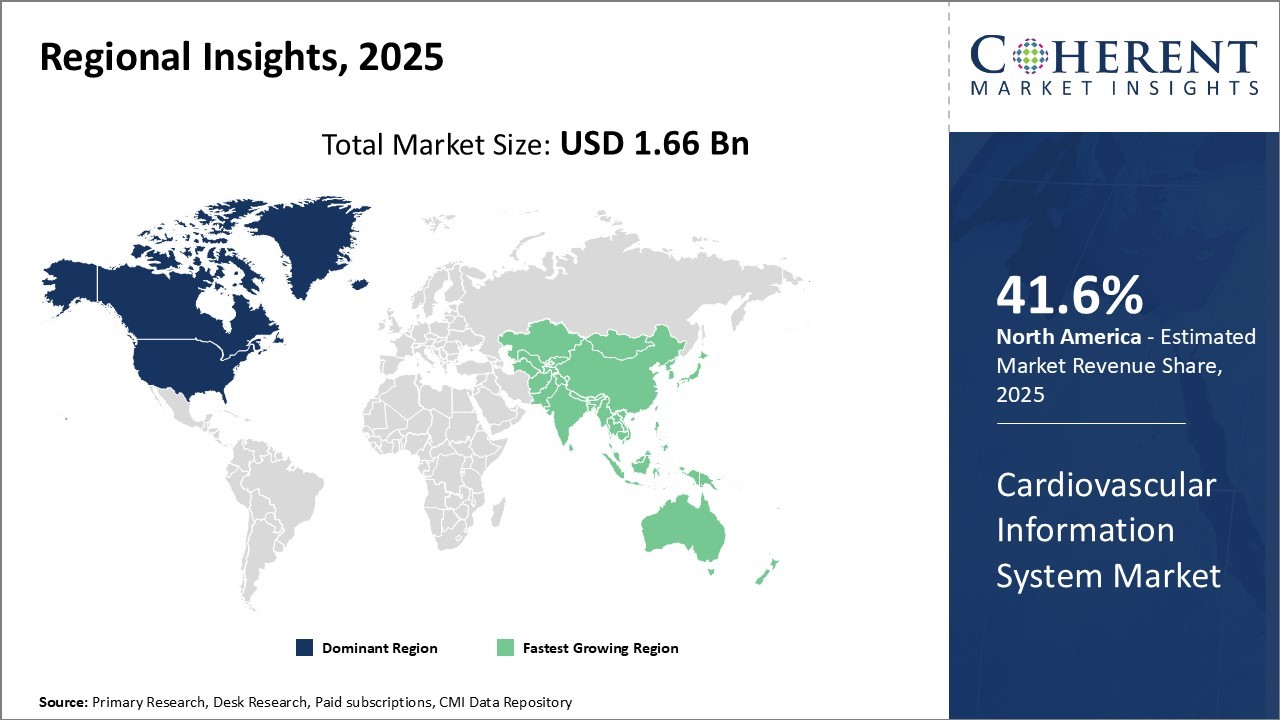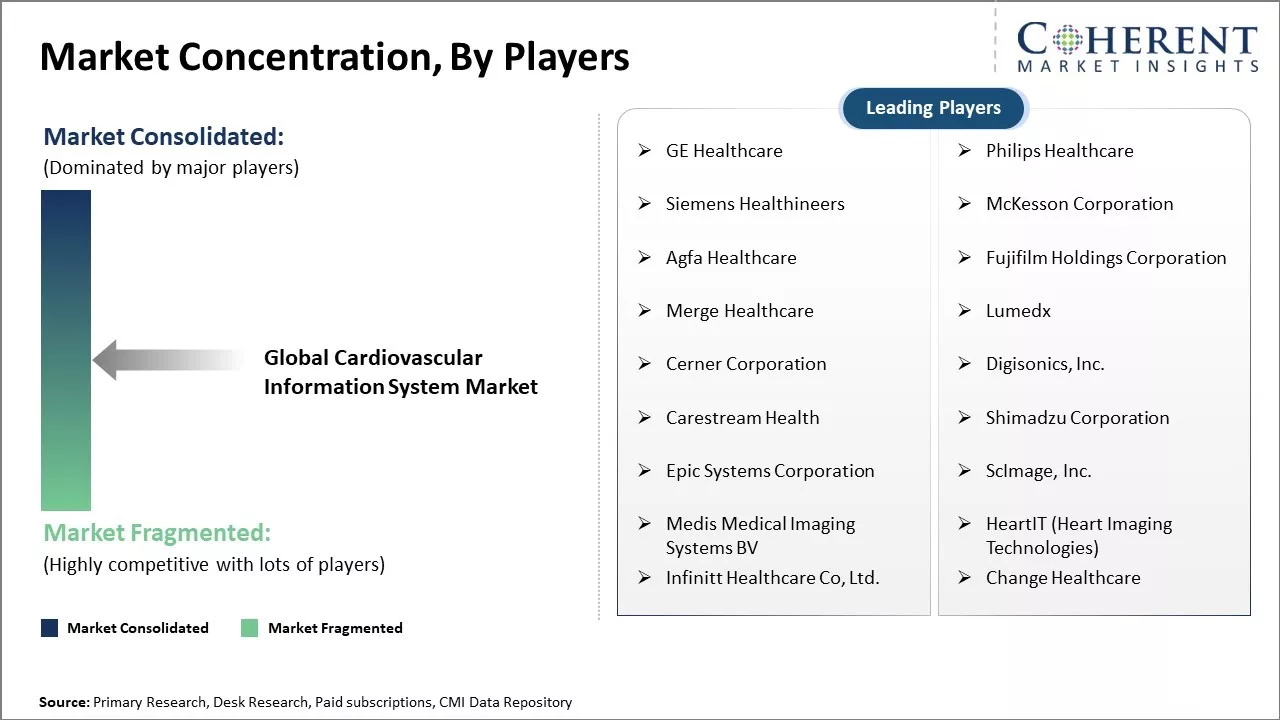The global cardiovascular information system market is estimated to be valued at USD 1.66 Bn in 2025 and is expected to reach USD 3.17 Bn by 2032, exhibiting a compound annual growth rate (CAGR) of 9.7% from 2025 to 2032.

To learn more about this report, Download Free Sample
The cardiovascular information system market is driven by the increasing prevalence of cardiovascular diseases and growing adoption of advanced technologies among healthcare providers. Rising geriatric population which is more prone to develop heart diseases and implementation of government initiatives to create awareness about heart health have also augmented the demand for cardiovascular information systems. Additionally, increasing investments by key players to develop more innovative and integrated solutions will further aid the market growth over the forecast period. However, high installation costs associated with these systems may hamper the cardiovascular information system market growth to some extent.
|
Current Events |
Description and its impact |
|
Regulatory Developments in AI-Enabled Medical Devices |
|
|
U.S.-China Trade Policy Shifts |
|
|
Remote Care Infrastructure Expansion |
|
Uncover macros and micros vetted on 75+ parameters: Get instant access to report
Artificial Intelligence (AI) is playing a crucial role in modern Cardiovascular Information Systems (CVIS) by enhancing clinical workflows, improving diagnostic accuracy, and enabling better integration of patient data. AI helps streamline routine tasks, reduce manual errors, and support timely decision-making by analyzing large volumes of cardiovascular data, such as ECGs, imaging, and hemodynamic parameters. It also facilitates seamless data sharing across systems and strengthens cybersecurity through intelligent threat detection.
In March 2025, when GE HealthCare introduced the AltiX AI.i editions of its Mac-Lab, CardioLab, and ComboLab systems. These AI-powered systems are designed to enhance the user experience, streamline workflows in cath and electrophysiology (EP) labs, support complex cardiac procedures, improve interoperability, and uphold strong cybersecurity measures—clearly demonstrating how AI can significantly elevate the capabilities of a CVIS.
Cloud based is expected to contribute the highest share of the market with 60.0% in 2025. Cloud technology has seen tremendous innovation in recent years, with improvements in virtualization, automation, and hosting infrastructure, making cloud platforms far more reliable and flexible than traditional on-premise systems. Healthcare providers can now leverage cloud-based cardiovascular information systems to gain insights from massive datasets and integrate disparate sources of health data more seamlessly. The ability of cloud platforms to horizontally and vertically scale computational resources on demand allows cardiovascular departments and clinics of all sizes to optimize hardware expenses. By avoiding large upfront capital costs for servers and ongoing maintenance, the pay-as-you-go model of cloud computing significantly lowers the financial barrier to entry for advanced cardiac data management capabilities.
Additionally, cloud deployment simplifies system updates, allowing new features and bug fixes to be rolled out seamlessly across all client workstations via the internet. For instance, in January 2023, Canon Medical Systems USA, a division of Canon Medical Systems Corp., formed a new strategic alliance with ScImage, a California-based healthcare technology firm specializing in enterprise imaging. This partnership is expected to strengthen Canon’s presence and expand its market share in the cardiovascular sector.
Software is expected to contribute the highest share of the market with 30.71% in 2025. Given the variable needs of cardiovascular departments ranging from academic medical centers to private clinics, customizable software proves indispensable. Leading cardiovascular vendors offer rich customizable features that allow facilities to tightly integrate solutions with their existing workflows, clinical priorities, and reporting requirements.
Complex scheduling algorithms, clinical decision support modules, and interfaces with peripheral lab systems can all be tailored according to each organization’s unique practices. Custom software also facilitates integration of evolving interventional techniques and therapeutic areas into the overall clinical data management protocol. For instance, ZHealth, a medical coding software provider, has launched Etch, the first software platform designed to tackle both documentation and coding challenges associated with complex cardiovascular procedures.
Catheterization is expected to contribute the highest share of the market with 20.73% in 2025. Catheterization labs have benefited tremendously from advancements in digital information management. Cardiovascular is tailored for catheterization integrate imaging, hemodynamics measurements, angiograms, and other intraprocedural data streams. Combined with supportive analytics, these systems improve diagnostic accuracy for conditions such as coronary artery disease. Physicians leverage detailed visualizations of vascular anatomies, blood flow simulations, and multiplanar reconstructions to precisely guide interventional techniques. This results in superior clinical outcomes, shortened procedure times, and reduced radiation exposure.
Additionally, as catheter-based therapies evolve to incorporate drug-eluting stents, balloon angioplasty, atherectomy, and other minimally invasive options, corresponding modules within cardiovascular IS elucidate complex treatment algorithms. Boston Scientific Corporation has received FDA 510(k) clearance for its new FARAVIEW™ Software, designed to integrate with the FARAPULSE™ Pulsed Field Ablation (PFA) System to enhance visualization during cardiac ablation procedures. The company also secured FDA approval for its navigation-enabled FARAWAVE™ NAV Ablation Catheter, intended for treating paroxysmal atrial fibrillation (AF).
Hospitals are actively driving the growth of the cardiovascular information systems (CVIS) market by seeking scalable, integrated, and efficient data management solutions. With the rising prevalence of cardiovascular diseases, they are increasingly adopting advanced CVIS technologies to enhance patient outcomes, boost diagnostic precision, and streamline clinical workflows. These systems enable hospitals to collect real-time data, generate structured reports, and integrate seamlessly with imaging and EHR platforms. Regulatory requirements, the demand for quality metrics, and the push to reduce procedure times are further motivating hospitals to implement these cutting-edge systems at a faster pace. For instance, in March 2025, Apollo Hospitals, one of India’s largest hospital chains, has announced a new collaboration to enhance its AI-based cardiovascular risk assessment tool. The hospital group is partnering with Solventum Health Information Systems, a 3M spinoff, to strengthen cardiovascular care by integrating Solventum’s patient classification and quality improvement methodologies.

To learn more about this report, Download Free Sample
North America dominates the overall market with a share of 41.6%. Cardiovascular information systems (CVIS) market in North America is growing rapidly as healthcare providers leverage innovation and a well-established infrastructure. Hospitals are increasingly adopting web-based and cloud-enabled technologies—now making up about 75% of deployments—to support remote cardiology and telehealth services. Leading vendors like Philips, GE, Siemens, and Cerner are driving advancements through strong R&D and AI-powered imaging and predictive tools. Stricter interoperability and regulatory standards under HITECH and HIPAA, along with the region’s high cardiovascular disease burden, continue to boost CVIS adoption. For instance, in October 2024, Boston Scientific Corp. received FDA 510(k) clearance for its new FARAVIEW software, which enhances visualization during cardiac ablation procedures when used with the FARAPULSE Pulsed Field Ablation (PFA) System. This is further accelerating the cardiovascular information system market demand.
Hospitals across Asia Pacific are actively adopting CVIS to enhance scalability, lower infrastructure expenses, and deliver telecardiology services, especially in underserved and remote areas. Vendors are integrating AI and machine learning into CVIS tools like automated echo analysis and cardiovascular risk prediction to boost diagnostic precision and efficiency. Meanwhile, governments are accelerating adoption by investing heavily in digital health initiatives and strengthening healthcare infrastructure, including EHR and CVIS integration.
For instance, in May 2025, the National Heart Centre Singapore (NHCS) introduced the Cardiovascular Ageing and Longevity (CRANE) program, marking a significant advancement in specialized cardiac care for the elderly. This initiative is the first comprehensive program of its kind in the Asia-Pacific region.
India is rapidly expanding telecardiology access across both urban and rural areas by adopting cloud-based CVIS and AI-driven remote cardiac monitoring, as seen in collaborations like AliveCor–OMRON and platforms like Remo. Cardia Government initiatives such as the Ayushman Bharat Digital Mission and EHR standardization are actively building a national digital health infrastructure that enables seamless CVIS integration. For instance, in April 2023, researchers at the Indian Institute of Technology, Madras (IIT-M) developed a portable device, similar in size to digital blood pressure monitors, to assess the age and condition of blood vessels and support early detection of cardiovascular diseases.
Web and cloud-based CVIS solutions dominate Europe’s market as healthcare providers actively adopt them to reduce IT costs and minimize on-site hardware requirements. These platforms offer improved data accessibility, GDPR-compliant backups, and lower operational expenses. Providers are increasingly using them to enable telecardiology and cross-site collaboration. At the same time, European governments are funding hospital-wide CVIS integration and executing national digital health strategies. For instance, in January 2025, Ncardia, a leading provider of human induced pluripotent stem cell (hiPSC) technology, unveiled Ncyte® Heart in a Box, an innovative 3D cardiac microtissue model designed to drive advancements in cardiovascular research and drug development.

To learn more about this report, Download Free Sample
| Report Coverage | Details | ||
|---|---|---|---|
| Base Year: | 2024 | Market Size in 2025: | USD 1.66 Bn |
| Historical Data for: | 2020 To 2024 | Forecast Period: | 2025 To 2032 |
| Forecast Period 2025 to 2032 CAGR: | 9.7% | 2032 Value Projection: | USD 3.17 Bn |
| Geographies covered: |
|
||
| Segments covered: |
|
||
| Companies covered: |
GE Healthcare, Philips Healthcare, Siemens Healthineers, McKesson Corporation, Agfa Healthcare, Fujifilm Holdings Corporation, Merge Healthcare, Lumedx, Cerner Corporation, Digisonics, Inc., Carestream Health, Shimadzu Corporation, Epic Systems Corporation, ScImage, Inc., Medis Medical Imaging Systems BV, HeartIT (Heart Imaging Technologies), Infinitt Healthcare Co, Ltd., and Change Healthcare |
||
| Growth Drivers: |
|
||
| Restraints & Challenges: |
|
||
Uncover macros and micros vetted on 75+ parameters: Get instant access to report
Healthcare providers are rapidly adopting cloud-based CVIS platforms to enhance scalability, enable remote access, and reduce the burden on IT infrastructure. These solutions allow real-time data sharing, centralized management across multiple facilities, and effective disaster recovery. By implementing cloud systems, providers also expand access to telecardiology services, particularly in remote or underserved regions. As data volumes continue to grow and remote care becomes standard practice, cardiology departments increasingly rely on cloud-based platforms to stay future-ready and maintain clinical efficiency.
As healthcare systems demand seamless integration with EHRs, PACS, and other clinical platforms, developers have made interoperability a key priority in CVIS advancement. By adopting standards such as HL7 and FHIR, providers are streamlining data exchange, minimizing information silos, and ensuring continuity of care. Vendors are now prioritizing plug-and-play capabilities that allow CVIS solutions to operate efficiently within broader digital health ecosystems.
The growing healthcare IT industry in emerging markets such as India, China, and Southeast Asia presents a great opportunity for the global cardiovascular information system market. As economies in these regions are developing rapidly, governments are investing heavily in modernizing their healthcare infrastructure and digitizing patient medical records. This aims to not only improve access and quality of care for their huge populations but also make important healthcare data available seamlessly to doctors and hospitals. Cardiovascular information systems, which enable the electronic filing and retrieval of cardiology department reports such as echocardiograms, cardiac catheterizations and treadmill tests, are well-positioned to benefit from this healthcare technology transformation.
Share
Share
About Author
Manisha Vibhute is a consultant with over 5 years of experience in market research and consulting. With a strong understanding of market dynamics, Manisha assists clients in developing effective market access strategies. She helps medical device companies navigate pricing, reimbursement, and regulatory pathways to ensure successful product launches.
Missing comfort of reading report in your local language? Find your preferred language :
Transform your Strategy with Exclusive Trending Reports :
Frequently Asked Questions
Joining thousands of companies around the world committed to making the Excellent Business Solutions.
View All Our Clients